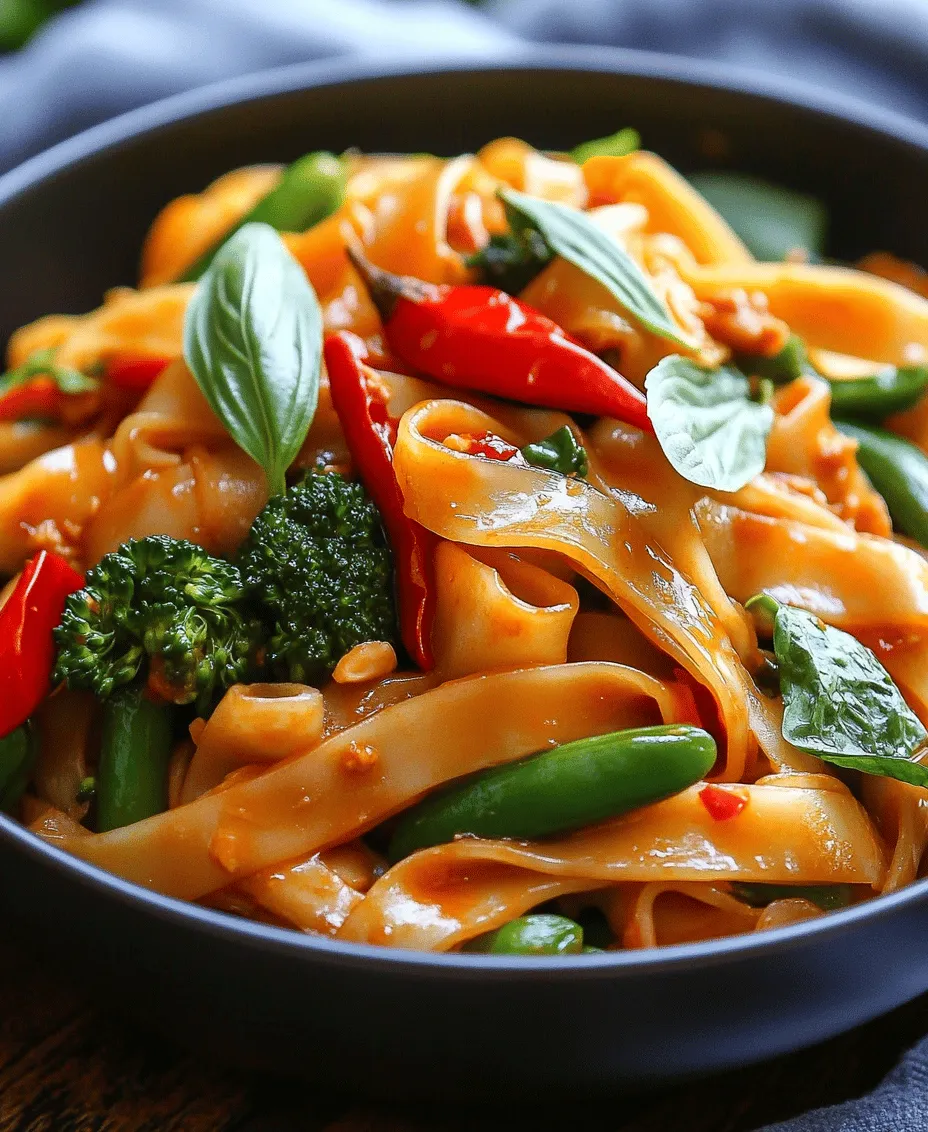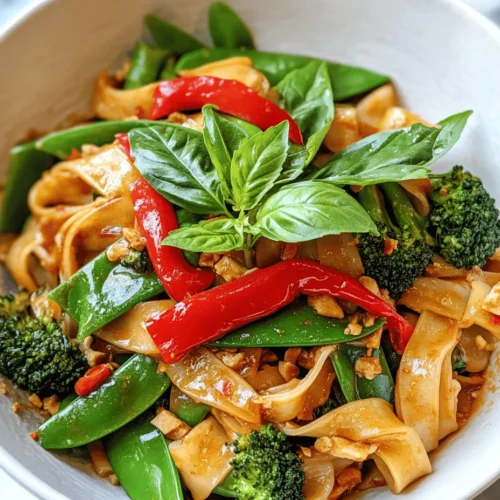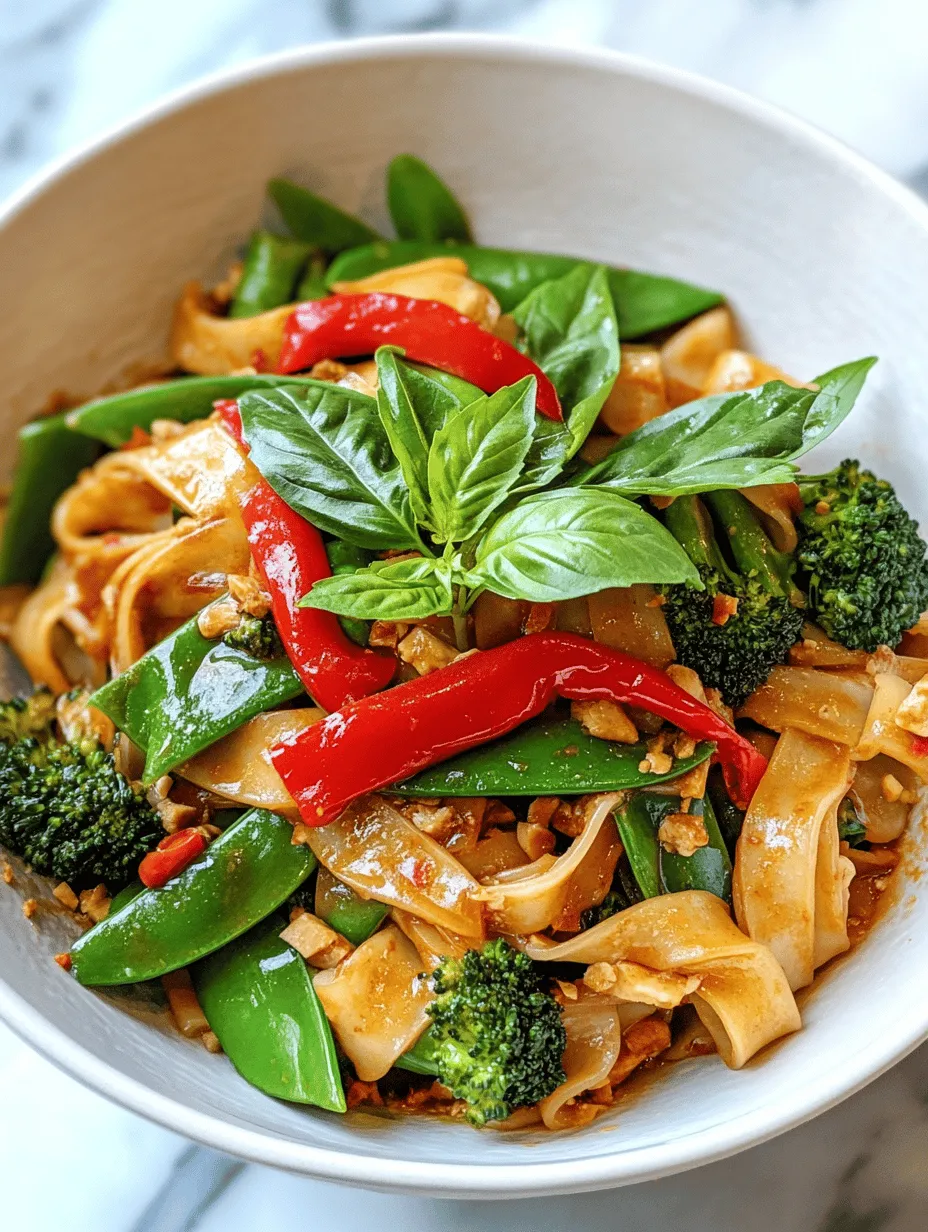Introduction
Welcome to the vibrant world of Thai cuisine, where flavors dance, aromas tantalize, and each dish tells a unique story. Among the many culinary gems that Thailand has to offer, one dish stands out for its bold flavors and satisfying textures: Spicy Drunken Noodles Delight. This dish, also known as “Pad Kee Mao,” is a stir-fried noodle dish that perfectly encapsulates the essence of Thai cooking. Combining flat rice noodles with an aromatic medley of fresh vegetables, proteins, and a spicy sauce, it is a favorite among both locals and international food enthusiasts.
The origins of Drunken Noodles are as intriguing as the dish itself. Traditionally, the dish is believed to have been created as a late-night snack for revelers returning from a night out, hence the name “drunken.” It is thought that the dish’s spicy and flavorful profile was a remedy for those who may have indulged a bit too much. Over the years, it has evolved into a staple in Thai restaurants worldwide, celebrated for its ability to satisfy cravings and delight the palate.
At the heart of Spicy Drunken Noodles Delight is the harmonious balance of flavors and textures that Thai cuisine is renowned for. The chewy flat rice noodles are complemented by the crispness of fresh vegetables, the umami richness of the sauce, and the heat from various spices. Each bite delivers a burst of flavor, making it a dish that is not only delicious but also immensely satisfying.
Understanding Drunken Noodles
Drunken Noodles, or Pad Kee Mao, is more than just a dish; it is a cultural icon within Thai gastronomy. The name “Pad Kee Mao” translates to “stir-fried crazy,” reflecting the dish’s lively and adventurous nature. Typically, the dish is made with wide, flat rice noodles that are stir-fried with a combination of fresh vegetables, protein (such as chicken, shrimp, or tofu), and a flavorful sauce that includes soy sauce, oyster sauce, and a hint of chili.
One of the key aspects of Drunken Noodles is the regional variations that exist throughout Thailand. For instance, in some areas, the dish may be prepared with a more pronounced sweetness, while in others, it may lean towards the spicy side. This flexibility allows for creativity and personalization, making it a popular choice for home cooks and chefs alike.
The role of spice and aromatics in Thai cooking cannot be understated. Drunken Noodles often feature ingredients such as garlic, Thai basil, and bird’s eye chilies, all of which contribute to the dish’s signature heat and aroma. The interplay of these ingredients is what elevates the dish from simple stir-fried noodles to a delightful culinary experience.
Ingredients Breakdown
To create an authentic Spicy Drunken Noodles Delight, it is essential to use a variety of fresh ingredients that work together to deliver a complex flavor profile. Here is a breakdown of the key components:
1. Flat Rice Noodles
The foundation of this dish is the flat rice noodles, typically referred to as “sen yai” in Thai. These noodles have a chewy texture that holds up well against the sauce and other ingredients. When prepared correctly, they provide a satisfying bite that is essential for the overall experience of the dish.
2. Fresh Vegetables
A colorful assortment of vegetables adds both nutrition and texture to the dish. Common choices include bell peppers, broccoli, carrots, and baby corn. These vegetables not only enhance the visual appeal but also contribute to the dish’s crunch and freshness.
3. Protein
While traditional recipes may call for chicken or shrimp, this dish is highly versatile, allowing for substitutions based on dietary preferences. Tofu is an excellent plant-based alternative, while beef or pork can be used for those who prefer red meat. Each protein choice brings a different flavor and texture, which can elevate the dish further.
4. Sauces
The sauce is the star player in Spicy Drunken Noodles, as it ties all the elements together. A quintessential mix of soy sauce, oyster sauce, and fish sauce creates a balance of salty, savory, and umami flavors. Adjusting the ratio of these sauces allows for customization in flavor intensity, making it easy to cater to personal preferences.
5. Aromatics and Spices
Garlic, shallots, and Thai basil are crucial for infusing the dish with aromatic depth. Fresh bird’s eye chilies add a fiery kick, while other spices like white pepper can be used to enhance the overall flavor. The careful selection and preparation of these ingredients are vital for achieving the authentic essence of Spicy Drunken Noodles.
Ingredient Substitutions
For those with dietary restrictions or preferences, there are various substitutions that can be made without sacrificing flavor. For instance, gluten-free soy sauce can replace regular soy sauce for those with gluten sensitivities. Additionally, a variety of vegetables can be used based on availability or seasonality, such as zucchini, snap peas, or even bean sprouts.
Preparation Steps Explained
Once you have gathered all your ingredients, it’s time to dive into the preparation process. Each step is designed to maximize flavor and ensure that the dish comes together seamlessly.
Soaking the Noodles
The first step in preparing Spicy Drunken Noodles is soaking the flat rice noodles. Unlike traditional pasta, these noodles require a bit of care to achieve the perfect texture. Soak them in warm water for about 30 minutes or until they are pliable but not fully cooked. This step is crucial as it prevents the noodles from becoming mushy during stir-frying. Once soaked, drain and set aside.
Crafting the Sauce
Next, it’s time to create the sauce that will bring the dish to life. In a small bowl, mix together equal parts soy sauce, oyster sauce, and fish sauce. For a spicy kick, add a dash of chili paste or a few finely chopped bird’s eye chilies, depending on your heat preference. This sauce will not only coat the noodles but also infuse the entire dish with flavor. Don’t be afraid to taste and adjust the seasoning to your liking.
Sautéing Techniques
The final step before cooking the noodles is to prep your aromatics. Heat a wok or a large skillet over medium-high heat and add a splash of oil. When the oil is hot, add minced garlic and shallots, stirring quickly to prevent burning. This is where the magic begins, as the sizzling garlic fills the kitchen with an irresistible aroma.
Once the aromatics are fragrant, it’s time to add your protein of choice. Stir-fry until the protein is cooked through, then toss in the soaked noodles and vegetables. Pour in the prepared sauce, and use a spatula to gently toss everything together. The goal is to ensure that every strand of noodle is coated in the sauce, while the vegetables retain their crunch.
As you stir-fry, keep an eye on the cooking time; the entire process should take no longer than a few minutes. Adding fresh Thai basil at the end of cooking provides a fragrant finish to the dish.
With these preparation steps completed, you are well on your way to enjoying a delicious plate of Spicy Drunken Noodles Delight. This dish is not only a feast for the senses but also a testament to the rich culinary heritage of Thailand. Stay tuned for the next part of this article, where we’ll dive deeper into the cooking process and final touches that make this dish truly unforgettable.

Step-by-Step Guide to Stir-Frying: Tips for Maintaining Vegetable Crispness
Stir-frying is a quick cooking method that requires precision and timing, especially when it comes to maintaining the crispness of your vegetables. Here’s how to do it effectively:
1. Prep Ingredients Ahead: Ensure all vegetables are cut and ready before you start cooking. This allows you to cook quickly and prevents any items from overcooking.
2. Choose the Right Oil: Use oils with high smoke points, such as vegetable oil, canola oil, or peanut oil. These oils can withstand the high temperatures of stir-frying without burning.
3. High Heat: Always preheat your wok or pan on high heat. A hot cooking surface is crucial for proper stir-frying, helping to sear the vegetables quickly and lock in their freshness.
4. Don’t Overcrowd the Pan: Cook in batches if necessary. Overcrowding can lower the pan’s temperature, leading to steaming rather than frying. This will result in soggy vegetables instead of crisp ones.
5. Add Vegetables in Stages: Start with the heartier vegetables (like carrots and bell peppers) that take longer to cook, and add the more delicate ones (like bok choy or snow peas) later in the process. This ensures everything cooks evenly.
6. Quick Tossing: Use a spatula to toss the vegetables frequently. This keeps them moving and ensures they cook evenly without burning.
By adhering to these tips, your vegetables will retain their vibrant colors and crunchy textures, adding to the overall appeal of your Spicy Drunken Noodles Delight.
Importance of Cooking Order: Why Proper Sequencing Matters in Stir-Frying
The order in which you add ingredients to your stir-fry can significantly affect the final dish. Here’s why sequencing is crucial:
– Cooking Times Vary: Different ingredients have varying cooking times. Starting with proteins (like chicken, shrimp, or tofu) allows them to cook through before adding quicker-cooking vegetables.
– Flavor Development: Aromatics, such as garlic and onion, should be added at the beginning to develop their flavors, while fresh herbs like Thai basil should be added towards the end to preserve their brightness.
– Sauce Incorporation: Adding sauces at the right time helps them coat the ingredients evenly. For instance, adding your sauce after the proteins and vegetables are cooked ensures they absorb the flavors without becoming soggy.
By following this cooking order, you can achieve a harmonious blend of tastes and textures that is characteristic of authentic Thai cuisine.
Incorporating Proteins: How to Adapt the Recipe for Various Dietary Preferences
Spicy Drunken Noodles Delight is a versatile dish that can be easily adapted to accommodate different dietary preferences. Here are some options:
– For Meat Lovers: Traditional recipes often use chicken or shrimp. Simply marinate your protein of choice with soy sauce and a hint of lime before stir-frying to enhance the flavors.
– Pescatarian Option: Substitute chicken with shrimp or fish. Quick-cooking proteins work well here, adding a delightful seafood flavor to your noodles.
– Vegetarian Adaptation: Replace meat with tofu or tempeh. For a protein-packed version, use firm tofu, marinated and stir-fried until golden brown.
– Vegan Version: Use the vegetarian adaptations and ensure that the sauces used (like soy sauce) are vegan-friendly. You can also pack in more vegetables for a hearty meal.
– Gluten-Free Option: Substitute regular soy sauce with tamari or coconut aminos, which are gluten-free.
By customizing the protein, you can make this dish accessible for everyone at your table while keeping the core flavors intact.
Flavor Profile Exploration
To truly appreciate Spicy Drunken Noodles Delight, it’s essential to explore its complex flavor profile.
– Sweetness: The dish often incorporates sugar or sweet soy sauce, providing a subtle sweetness that balances the heat of the chilies.
– Savory Notes: The umami from soy sauce enhances the overall depth of flavor, creating a satisfying base that complements the other ingredients.
– Spiciness: The heat typically comes from fresh Thai chilies or chili paste, ensuring a fiery kick that characterizes this dish. Adjust the heat to your preference by controlling the amount of chili used.
– Aromatic Qualities: Fresh garlic and ginger add aromatic notes that elevate the dish, while the addition of lime juice brightens the flavors, making each bite invigorating.
The role of Thai basil in this recipe cannot be understated. This herb not only contributes a unique flavor that’s slightly sweet and peppery but also adds a fragrant aroma that enhances the sensory experience of the dish. Be sure to use fresh Thai basil rather than regular basil for the best results.
Lime juice plays a pivotal role in balancing the rich flavors of the noodles, cutting through the heaviness and providing a refreshing contrast. This acidity is critical in creating a well-rounded dish, ensuring that each component shines without overwhelming the palate.
Serving Suggestions
Presentation is key when serving Spicy Drunken Noodles Delight. Here are some ideas to elevate your dish:
– Garnishing: Top your noodles with freshly chopped Thai basil and a wedge of lime. This not only adds visual appeal but also enhances the dish’s aroma and flavor when served.
– Ideal Accompaniments: Consider serving the noodles with a side of Thai spring rolls or a light cucumber salad dressed with rice vinegar. These options provide a refreshing contrast to the richness of the noodles.
– Beverage Pairings: A cold Thai iced tea or a light beer complements the dish beautifully. Alternatively, a citrus-based cocktail can enhance the vibrant flavors of the noodles.
– Portioning for Occasions: For casual meals, serve the noodles family-style in a large bowl, allowing everyone to help themselves. For a dinner party, consider plating individual servings, garnished elegantly to impress your guests.
By paying attention to presentation and pairing, you can create a dining experience that is both visually stunning and delicious.
Nutritional Overview
Understanding the nutritional benefits of your meal can enhance your overall dining experience. Here’s a breakdown of what to expect from a serving of Spicy Drunken Noodles Delight:
– Nutritional Values: A typical serving provides approximately 400-500 calories, depending on the protein and vegetables used. It also delivers a good mix of carbohydrates, proteins, and fats.
– Health Benefits of Key Ingredients: The vegetables in your dish—like bell peppers, carrots, and broccoli—are packed with vitamins and minerals. They provide essential nutrients while adding color and texture. Thai basil is rich in antioxidants, which can contribute to overall health.
– Dietary Considerations: This dish can be tailored to meet various dietary restrictions. It’s naturally gluten-free when using the right sauces and can be made vegetarian or vegan without sacrificing flavor.
Being mindful of ingredient choices can help you enjoy a fulfilling meal that aligns with your dietary goals.
Conclusion
Spicy Drunken Noodles Delight is not just a meal; it’s an experience that showcases the vibrant and diverse flavors of Thai cuisine. With its perfect balance of sweet, savory, and spicy notes, this dish is a must-try for anyone looking to explore the depths of flavor in Asian cooking.
Embrace the opportunity to customize this recipe to suit your taste and dietary needs, making it a versatile option for any occasion. We encourage you to try your hand at this delightful dish, whether for a casual family dinner or a sophisticated gathering with friends.
As you experiment with the flavors and ingredients, we invite you to share your experiences or any personal twists you’ve added to the recipe in the comments. Your culinary stories could inspire others to dive into the world of Thai cooking!



